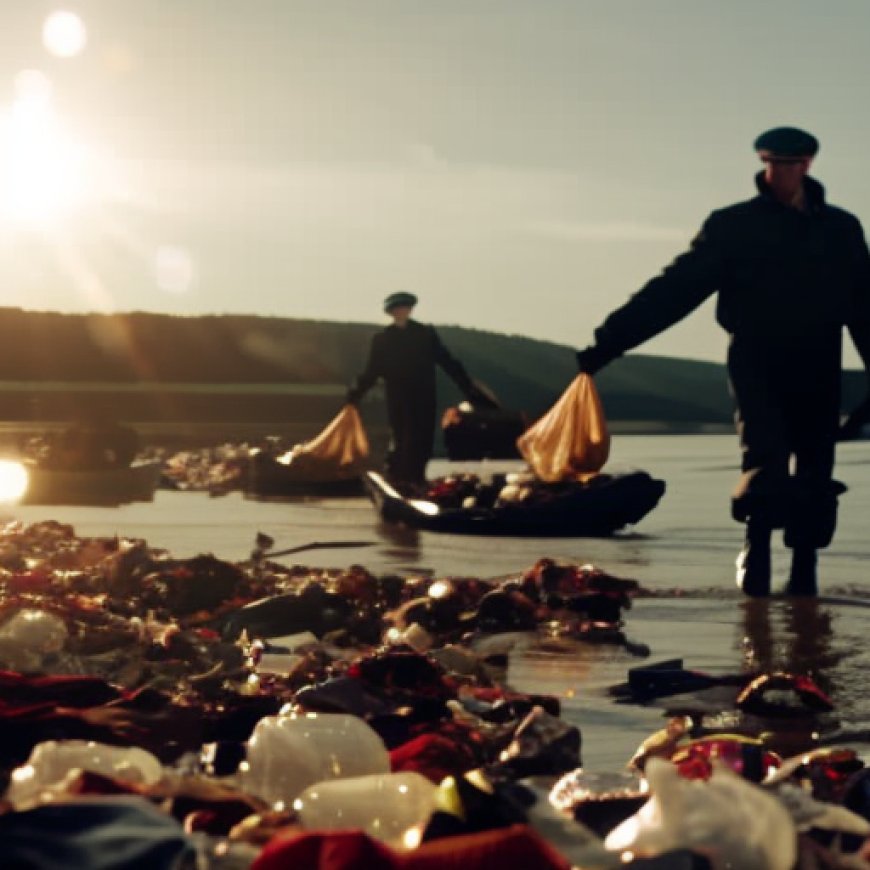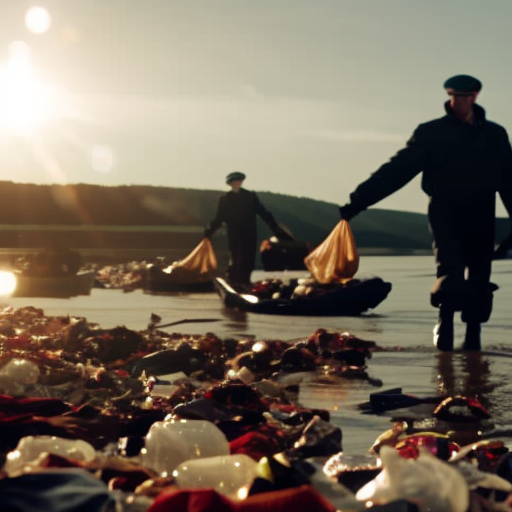Volunteers head off plastic waste crisis by removing tons of rubbish from Hungarian river
Volunteers head off plastic waste crisis by removing tons of rubbish from Hungarian river ABC News


Tackling Plastic Pollution: The Plastic Cup Initiative

Introduction
Thousands of muddy plastic bottles, chunks of Styrofoam, and other waterlogged pieces of rubbish were recently removed from the Tisza River in Hungary. This metric ton of waste was collected by volunteers participating in the annual Plastic Cup competition, a 10-day event that aims to clean up Hungary’s waterways and prevent waste from reaching the seas and oceans.
The Plastic Cup Competition
The Plastic Cup competition, which started in 2013, draws over 150 participants each year. These volunteers, equipped with canoes and life jackets, scour the Tisza River for trash. The competition offers a prize for those who collect the most trash, motivating participants to gather as much waste as possible. Since its inception, the Plastic Cup competition has gathered over 330 tons (727,000 pounds) of waste from the Tisza and other Hungarian waters.
Sustainable Development Goals (SDGs)
The Plastic Cup initiative aligns with several Sustainable Development Goals (SDGs), including:
- SDG 14: Life Below Water – By preventing waste from entering the oceans, the initiative contributes to the preservation of marine ecosystems and biodiversity.
- SDG 12: Responsible Consumption and Production – The Plastic Cup promotes responsible waste management and recycling practices.
- SDG 13: Climate Action – By reducing plastic pollution, the initiative helps mitigate the environmental impact of plastic manufacturing and its contribution to climate change.
The Global Plastic Pollution Crisis
The Plastic Cup’s competition director, Zsolt Tamas, emphasizes the global ecological crisis caused by waste pollution. Rivers are identified as the biggest source of global waste pollution, as waste travels downstream and accumulates in the oceans. Tamas highlights the importance of prevention and solving the problem at its source to reduce waste entering the oceans.
Environmental and Health Risks
Exposure to plastic pollution poses grave ecological and human health risks. Carbon dioxide emissions from plastic manufacturing contribute to climate change, while microplastics can have detrimental effects on hormones, fertility, and various bodily systems. Microplastics have been found in remote locations such as ocean depths, mountain glaciers, and even human bodies.
Efforts on the Tisza River
The Plastic Cup volunteers disembark from their canoes and venture into the dense vegetation along the Tisza River’s banks to collect waste. They utilize an open-source online application to mark locations with significant trash deposits. The collected waste is then sorted on makeshift rafts before being sent for recycling or disposal in landfills. Despite their efforts, a significant amount of waste remains inaccessible, embedded in the riverbed sludge.
Microplastic Concentration on the Tisza River
A recent study by the University of Szeged found high concentrations of microplastics in the Tisza River. The presence of 3-4,000 microplastic fragments per kilogram of sediment exceeds levels found in India’s heavily polluted Ganges River.
Addressing the Issue at its Source
The Plastic Cup initiative recognizes that a majority of the waste on the Tisza River originates from the Transcarpathia region of Ukraine. To address this, the initiative provided financial support for waste management efforts in Ukraine, resulting in the collection of 700 tons of waste from the Upper Tisza in 2022. However, the production of single-use plastics remains a significant challenge, with global plastic production projected to triple by 2060.
International Cooperation and Future Goals
The Plastic Cup has engaged in international cooperation with organizations in Serbia, Romania, and Bulgaria to share knowledge and experiences in fighting pollution in their respective rivers. The long-term goal is to bring the Tisza River and other waterways to a condition where they can be enjoyed without the need for extensive clean-up efforts.
Conclusion
The Plastic Cup initiative exemplifies the importance of collective action in addressing plastic pollution. By organizing annual clean-up competitions and promoting responsible waste management practices, the initiative contributes to achieving several SDGs. With continued efforts and international cooperation, it is possible to reduce plastic pollution and create a cleaner and more sustainable environment for future generations.
Associated Press climate and environmental coverage receives support from several private foundations. See more about AP’s climate initiative here. The AP is solely responsible for all content.
SDGs, Targets, and Indicators
1. Which SDGs are addressed or connected to the issues highlighted in the article?
- SDG 6: Clean Water and Sanitation
- SDG 11: Sustainable Cities and Communities
- SDG 12: Responsible Consumption and Production
- SDG 14: Life Below Water
- SDG 15: Life on Land
The article discusses the issue of plastic waste pollution in rivers and its impact on the environment and human health. This connects to SDG 6, which aims to ensure availability and sustainable management of water and sanitation for all. It also relates to SDG 11, which focuses on making cities and human settlements inclusive, safe, resilient, and sustainable. Additionally, the article addresses SDG 12, which promotes responsible consumption and production patterns to reduce waste generation. The issue of plastic waste pollution in rivers is also relevant to SDG 14, which aims to conserve and sustainably use the oceans, seas, and marine resources. Finally, it connects to SDG 15, which focuses on protecting, restoring, and promoting sustainable use of terrestrial ecosystems.
2. What specific targets under those SDGs can be identified based on the article’s content?
- SDG 6.3: Improve water quality by reducing pollution, eliminating dumping, and minimizing release of hazardous chemicals and materials.
- SDG 11.6: Reduce the adverse per capita environmental impact of cities, including by paying special attention to air quality and municipal and other waste management.
- SDG 12.5: By 2030, substantially reduce waste generation through prevention, reduction, recycling, and reuse.
- SDG 14.1: By 2025, prevent and significantly reduce marine pollution of all kinds, particularly from land-based activities, including marine debris and nutrient pollution.
- SDG 15.1: By 2020, ensure the conservation, restoration, and sustainable use of terrestrial and inland freshwater ecosystems and their services.
Based on the article’s content, the specific targets that can be identified are reducing water pollution (SDG 6.3), improving waste management in cities (SDG 11.6), reducing waste generation (SDG 12.5), preventing marine pollution (SDG 14.1), and ensuring the sustainable use of terrestrial and freshwater ecosystems (SDG 15.1).
3. Are there any indicators mentioned or implied in the article that can be used to measure progress towards the identified targets?
- Indicator for SDG 6.3: Concentration of pollutants in water bodies
- Indicator for SDG 11.6: Municipal waste collection coverage
- Indicator for SDG 12.5: Waste generation per capita
- Indicator for SDG 14.1: Marine litter density
- Indicator for SDG 15.1: Extent of water-related ecosystems
The article does not explicitly mention these indicators, but they can be used to measure progress towards the identified targets. These indicators would help track the concentration of pollutants in water bodies (SDG 6.3), the coverage of municipal waste collection (SDG 11.6), waste generation per capita (SDG 12.5), marine litter density (SDG 14.1), and the extent of water-related ecosystems (SDG 15.1).
4. Table: SDGs, Targets, and Indicators
| SDGs | Targets | Indicators |
|---|---|---|
| SDG 6: Clean Water and Sanitation | 6.3: Improve water quality by reducing pollution, eliminating dumping, and minimizing release of hazardous chemicals and materials. | Concentration of pollutants in water bodies |
| SDG 11: Sustainable Cities and Communities | 11.6: Reduce the adverse per capita environmental impact of cities, including by paying special attention to air quality and municipal and other waste management. | Municipal waste collection coverage |
| SDG 12: Responsible Consumption and Production | 12.5: By 2030, substantially reduce waste generation through prevention, reduction, recycling, and reuse. | Waste generation per capita |
| SDG 14: Life Below Water | 14.1: By 2025, prevent and significantly reduce marine pollution of all kinds, particularly from land-based activities, including marine debris and nutrient pollution. | Marine litter density |
| SDG 15: Life on Land | 15.1: By 2020, ensure the conservation, restoration, and sustainable use of terrestrial and inland freshwater ecosystems and their services. | Extent of water-related ecosystems |
Behold! This splendid article springs forth from the wellspring of knowledge, shaped by a wondrous proprietary AI technology that delved into a vast ocean of data, illuminating the path towards the Sustainable Development Goals. Remember that all rights are reserved by SDG Investors LLC, empowering us to champion progress together.
Source: abcnews.go.com

Join us, as fellow seekers of change, on a transformative journey at https://sdgtalks.ai/welcome, where you can become a member and actively contribute to shaping a brighter future.







